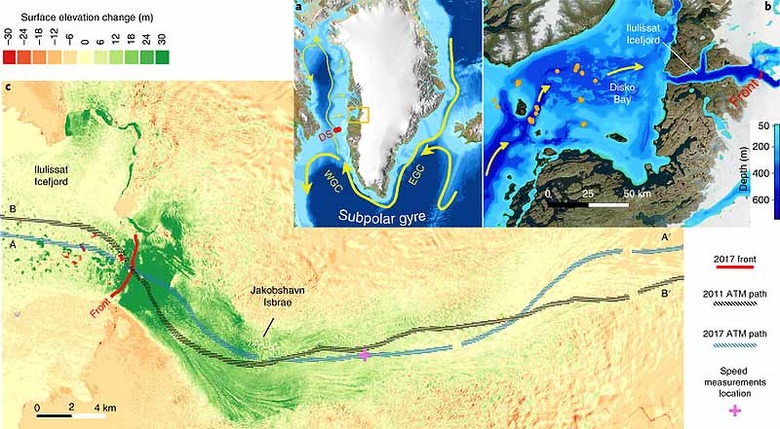This Glacier Growth Didn't Just Cancel Climate Change
A report from NASA showed that a glacier in Greenland was growing, but warned that the news isn't all positive. The fact that the glacier, Jakobshavn, seems to be growing is good news, at first glance. Melting glaciers is indicative of climate change and a major sign that pollution is destroying our planet's livable environment. But the way this glacier is growing isn't sustainable – and because it's only likely short-term growth, the knee-jerk reaction in the press and on social media platforms is to call all environmentalists frauds and global warming a lie.
Why is this not good news?
This is bad news largely because we live in a world where hyped headlines are the only thing the most vocal people read. Because the most powerful headline is effectively "glacier growing, time to stop all things green," that's what you'll find if you do a web search for "glacier" right this minute. That's bad.

If it were possible to appeal to the public's good-hearted and understanding nature, things would be different in this report. We'd be able to calmly explain that one growing glacier could be good – but this one isn't. This is all the fault of a climate pattern called the North Atlantic Oscillation (NAO).
Hold it NAO
NAO is a pattern in our planet's climate, switching between warm and cold every five to 20 years. According to NASA, the same folks who announced the glacier growth in the first place, this glacier growth will likely stop when NAO switches back – from cold to warm.
"Jakobshavn is getting a temporary break from this climate pattern," said Josh Willis of JPL, principal investigator of NASA's Oceans Melting Greenland mission (OMG). "But in the long run, the oceans are warming. And seeing the oceans have such a huge impact on the glaciers is bad news for Greenland's ice sheet."
Is global warming finished?
Climate change is still real, global warming is in effect, and global sea levels are continuing to rise. NASA's Oceans Melting Greenland (OMG) mission was part of the research which announced the growing of the glacier in the first place. This mission recorded cold water in the area for the last three years, consistent with the most recent NAO climate pattern switch.
Rapid cooling of the ocean current in southwest Greenland in early 2016, and cooler waters hit Jakobshavn at the same time as the glacier's flow started to slow. As the cold waters continued to reach the glacier, the glacier began to grow. But, again, not for long.
While the growth of the glacier is in effect in the short term, the research concludes that "Longer time series of ocean temperature, subglacial discharge and glacier variability strongly suggest that ocean-induced melting at the front has continued to influence glacier dynamics after the disintegration of its floating tongue in 2003."
It's not over yet.
For more information on the research cited in this report, head over to the paper "Interruption of two decades of Jakobshavn Isbrae acceleration and thinning as regional ocean cools." This report was authored by Ala Khazendar, Ian G. Fenty, Dustin Carroll, Alex Gardner, Craig M. Lee, Ichiro Fukumori, Ou Wang, Hong Zhang, Hélène Seroussi, Delwyn Moller, Brice P. Y. Noël, Michiel R. van den Broeke, Steven Dinardo, and Josh Willis.
This research was published in Nature Geoscience volume 12, pages 277–283 (2019) with code 10.1038/s41561-019-0329-3, published on the 25th of March, 2019. Right alongside this research is a report you'll also want to see, called, "Ocean fingerprints on glacier motion." This paper was authored by Rebecca H. Jackson and published in Nature Geoscience volume 12, pages 224–225 (2019) with code DOI:10.1038/s41561-019-0343-5 on the 25th of March, 2019.
